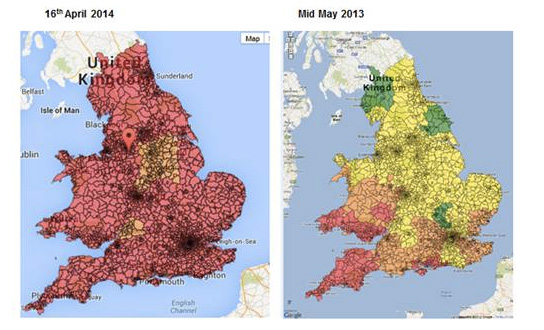
According to Dr Caroline Young from ADAS, this year's oilseed rape crops are up to a month ahead of the same time last year, with some plants flowering super-early.
The advanced crop state is borne of the recent unseasonably warm weather, Dr Young suggests, and accompanying it is a significantly earlier Sclerotinia risk compared to spring 2013.
Dr Young says: "The map colours indicate how close we are to the expected appearance of the Sclerotinia fungal fruiting bodies (an apothecium).”
“Red areas on the map indicate that apothecia are already present, or expected to appear imminently. This is in stark contrast to what was seen even as late as May last year.” In general the South West of England warms up first and the North East the latest. So, apothecia tend to be seen earliest in the South West, and latest in the North. The colour map broadly reflects this. However there will be variation with local topography and conditions."
She recommends that growers in all areas need to review their crop risk and plan their fungicide strategies accordingly.
“Most areas on the predictive map are now red, which agrees with what we are observing at BASF’s Sclerotinia monitoring sites, where germination has now started in all depots.”
“Any crops at early or mid-flower, which are in red areas, should be considered at risk from infection and it is likely that foliar fungicide applications now may be justified. Crops in the remaining orange areas will also be at risk shortly, so fungicide treatment now will also be beneficial, assuming a three week protection window for fungicides, under normal conditions.“
“Crops at late flower may also benefit from fungicide treatment; they are still at risk, but late infection tends to affect more of the lateral branches and therefore not be so damaging to yield as infection that occurs early and affects the main stems."
She adds that if lodging occurs however, infection occurring at any flowering phase can then spread rapidly through a crop by plant to plant spread.
In terms of timing, she advises that the main difference for growers this year, compared with 2013, is the calendar dates for early flower fungicide applications - growers will need to be applying fungicides now, or have already applied them, rather than the more usual time of later in April or into May.
“The usual guidelines for fungicide timing according to susceptible crop stage (open flowers), inoculum risk (sclerotial germination observations and predictions, and/or petal tests) and weather conditions (warm, light rain) will still apply.“
“However 2014 conditions have seen fungicides being applied earlier, where, if no other guidelines are taken into account, oilseed rape flowering began early and continues to progress earlier than in most years. Flowering onset is variable from year to year, but, for example in most years, ADAS Herefordshire trial sites have reached yellow bud in early- to mid-April.“
BASF's Sarah Mountford-Smith recommends that for applications targeted at Sclerotinia, growers should use Filan (boscalid) at 0.3-0.5 kg/ha, applied ideally before petal fall. "Both Filan and prothioconazole-based fungicides give excellent control of Sclerotinia, but, importantly, HGCA trials have shown that Filan consistently contributes a yield increase in the absence of disease.”
“It is also a different mode of action for resistance management of Light Leaf Spot, at a time when triazole resistant strains of Light Leaf Spot exist, and since spores will still be present in the crop. And finally, Filan is 'Bee-safe'; it can be mixed with pyrethroids for seed weevil control at flowering when bees are not foraging."
